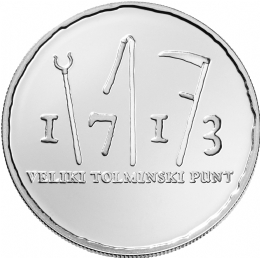Numismatics
300th anniversary of the Tolmin Peasant Revolt (2013)
Peasants in Slovenia rose up against their masters between the 15th and 17th centuries, as their social situation increasingly deteriorated due to wars, various diseases and taxes. The Tolmin Peasant Revolt was the last in a series of peasant uprisings in Slovenia before the reforms of Maria Theresa and Joseph II. It involved the countryside around Tolmin and Gorizia and part of Carniola. What characterised this revolt is that it was not against landowners, but against the government, in response to the new taxes. Since this period also saw a number of natural calamities strike the region, the peasants were no longer able to settle all their debts. The Gorizia County tax collector ordered the arrest of some men from the Tolmin area, enraging the local peasants who, under the leadership of Ivan Gradnik and others, began a revolt. On 27 March 1713 they marched from Tolmin to Gorizia with 500 men to free the imprisoned peasants. The plan was unsuccessful and the peasants dispersed.
The following day a mob of 5,000 gathered in the square, cutting the castle off from the town. The peasants were released from prison following negotiations, but not released from their obligation to pay taxes. The peasants were appeased for a time but in May the uprising of Tolmin peasants spread to the Trieste Karst area. The peasants formed an alliance and vowed not to pay any more taxes. Some 3,000 people gathered in Branik and elected their own emperor and governor. The aristocracy turned to the court for help. The court in turn issued an order for the assistance of the infantry and cavalry. Karlovac and Senj sent 600 soldiers who, together with imperial troops, crushed the revolt in the middle of June 1713. The leaders of the revolt and the peasants were arrested and imprisoned in Gorizia Castle, and the revolt was investigated by an imperial commission. A bloody judgement followed. Eleven leaders of the revolt were executed in the main square in Gorizia in April 1714. Others were sentenced to imprisonment or fined, while others still had their property seized.
Source: Tolmin Museum, Tolmin
Collector coins


The Republic of Slovenia is issuing collector coins to commemorate the 300th anniversary of the Tolmin Peasant Revolt. The coins bear the image of a scythe, flail and fire-tongs, representing the farming implements that the majority of peasants used in their fight.
Coin designer: Jernej Kejžar, Kranj / Slovenia.
Minting: Mincovna Kremnica, š.p., Kremnica / Slovakia.
| Gold coin | Silver coin |
|
Nominal value: EUR 100 |
Nominal value: EUR 30 Weight: 15 g Diameter: 32 mm Purty: Ag 925/1000 Issued: 2,000 coins |
| Put up for sale: 25 February 2013 | Put up for sale: 25 February 2013 |
| Collector bi-coloured coin | |
|
Nominal value: EUR 3 |
|
|
Put up for sale: 25 February 2013 |
|
Collector coin in plastic capsules
The Bank of Slovenia has prepared a special €3 proof collector coin issued to mark the 300th anniversary of theTolmin Peasant Revolt:
- 5,000 coins in plastic capsules.
They are on sale from 25 February 2013.
Production and minting: Mincovna Kremnica, š.p., Kremnica / Slovakia.
The list of Banka Slovenije's numismatic products and their availability as well as their price can be found at the following web page.


